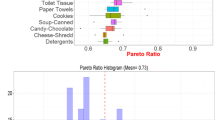Abstract
Marketers are becoming more aware of the growing importance of older consumers. In this paper the brand purchasing behavior of these consumers is investigated. The procedure uses Juster-scale purchase probabilities of brand choice as inputs to a Dirichlet model, enabling brand performance measures to be analyzed across age groups (< 40 years, 40–59 years, and 60–74 years). This approach is recommended for circumstances where it is too costly, too time-consuming, or too difficult to collect consumer panel data. The procedure is used to analyze purchasing in four contrasting types of product category that are representative of repertoire, subscription and mixed markets. Findings show age-based differences in product category purchasing, which impact on within-category brand purchasing (for instance, in terms of opportunities to buy more than one brand). However, patterns of buying between brands within a product category do not reveal marked age-based differences and leading brands tend to be leading for all age groups.
Similar content being viewed by others
References
Ahmad, R. (2002). The older or aging consumers in the UK: Are they really different? International Journal of Market Research, 44(3), 337–360.
Belk, R. W. (1985). Issues In The Intention-Behavior Discrepancy. In Sheth, J. (Ed.), Research in Consumer Behavior, 1. JAI Press, Greenwich, CT.
Buck, S. (1990). Exploring a Golden Business Opportunity. Maidenhead, England: McGraw-Hill.
Burt, S., & Gabbot, M. (1995). The Elderly Consumer And Non-Food Purchase Behaviour. European Journal of Marketing, 29(43), 2–57.
Brennan, M., & Esslemont, D. (1994). The Accuracy Of The Juster Scale For Predicting Purchase Rates Of Branded, Fast-Moving Consumer Goods. Marketing Bulletin, 5, 47–52.
Carrigan, M., & Szmigin, I. (2000). Advertising In An Ageing Society. Aging and Society, 20, 217–233.
Day, D., Gan, B., Gendall, P., & Esslemont, D. (1991). Predicting purchase behaviour. Marketing Bulletin, 2, 18–30.
Dekimpe, M. G., Steenkamp, J. B., Mellens, M., & Abeele, P. V. (1997). Decline And Variability In Brand Loyalty. International Journal of Research in Marketing, 14(5), 405–420.
Dubois, D., Laurent, G., & Quaghebeur, A. (1998). Determinants of Erroneous Self-Reporting Of Purchase Behaviour. Proceedings of the 27thEMAC Conference, 5, 453–460.
Ehrenberg, A. S. C., Goodhardt, G. J., & Barwise P. (1990). Double Jeopardy Revisited. Journal of Marketing, 54 (July), 82–91.
Ehrenberg, A. S. C., Uncles, M. D., & Goodhardt, G. J. (2004). Understanding Brand Performance Measures: Using Dirichlet benchmarks. Journal of Business Research, 57(12), 1307–1325.
Gordon, W., & Valentine, V. (2001). The 21st Century Consumer: An Endlessly Moving Target. Market Leader, 11, 50–55.
Hammond, K., Ehrenberg, A. S. C., & Goodhardt, G. J. (1996). Market Segmentation For Competitive Brands. European Journal of Marketing, 30(12), 39–49.
Johnson, T. (1984). The Myth Of Declining Brand Loyalty. Journal of Advertising Research, 24 (1), 9–17.
Juster, F. T. (1966), Consumer Buying Intentions And Purchase Probability: An Experiment in Survey Design, National Bureau of Economic Research, New York, Colombia University Press.
Kennedy, R., & Ehrenberg, A. S. C. (2000). Brand User Profiles Seldom Differ, R&DI Report, South Bank University, London.
Lambert-Pandraud, R., & Laurent, G. (2002). Older Respondents' Cautiousness and Questionnaire Answers: Increased Non-Responses vs Reduced Reliability. In Proceedings of the 31st EMAC Conference, Farhangmehr, M. (Ed.). University of Minho, Braga, Portugal, 28–31 May.
Lambert-Pandraud, R., Laurent, G., & Lapersonne, E. (2005). Repeat Purchasing of New Automobiles by Older Consumers: Empirical Evidence and Interpretations. Journal of Marketing, 69(2), 97–113.
Long, N. (1998). Broken Down By Age And Sex—Exploring The Ways We Approach The Elderly Consumer. Journal of the Market Research Society, 40(2), 73–90.
Radio Airtime Sales (1990). Brand Switching And The Baby Boomers. Radio Airtime Sales.
Reader's Digest (1989). Are The Middle-Aged More Brand Loyal Than The Young? Research Digest British Edition, Number 8, November.
Reader's Digest (2001). New Choices To Be Presenting Sponsor Of Active Living, Reader's Digest News Release, 30 April.
Reineck, J. A. (1964). The ‘older’ market: Fact or fiction? Journal of Marketing, 28, 60–64.
RTA (2003). New South Wales Driver & Vehicle Statistics 2003. Roads and Traffic Authority, NSW Government, Sydney.
Rungie, C. (2003). Metric Utility Model Version 2. University of South Australia: School of Marketing.
Sharp, B., Wright, M., & Goodhardt, G. J. (2002). Purchase Loyalty Is Polarised Into Either repertoire or subscription patterns. Australasian Marketing Journal, 10(3), 7–20.
Stern, P., & Hammond, K. (2004). The Relationship Between Customer Loyalty And Purchase Incidence. Marketing Letters, 15(1), 5–19.
Uncles, M. D., & Ehrenberg, A. S. C. (1990). Brand Choice Among Older Consumers. Journal of Advertising Research, August/September, 19–22.
Wright, M., Sharp A., & Sharp, B. (2002). Market Statistics For The Dirichlet Model: Using The Juster Scale To Replace Panel Data. International Journal of Research in Marketing, 19(1), 81–90.
Yang, Z., Zhou, N., & Chen, J. (2005). Brand Choice of Older Chinese Consumers. Journal of International Consumer Marketing, 17(4), 63–79.
Author information
Authors and Affiliations
Corresponding author
Rights and permissions
About this article
Cite this article
Uncles, M., Lee, D. Brand purchasing by older consumers: An investigation using the Juster scale and the Dirichlet model. Market Lett 17, 17–29 (2006). https://doi.org/10.1007/s11002-006-3756-z
Issue Date:
DOI: https://doi.org/10.1007/s11002-006-3756-z




